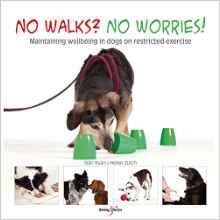
No walks? No worries! - Maintaining wellbeing for dogs on restricted exercise
This is a short book giving help to owners with dogs who can’t be as active as usual, perhaps after an operation, or an accident. Some of the advice is applicable to older dogs who can’t get about the way they used to. The introduction spells out the importance of walks, and the special experiences they bring that the convalescent will be missing. Chapter One helps owners to identify quirks that their dogs may have, that need to be taken into account in a care plan, such as a reluctance to be handled. Chapter Two follows on with preparation for a planned operation, for example, teaching dogs to greet humans without jumping up (not sensible after an operation), or to learn to wear a muzzle for examinations, if necessary. Chapter Three deals with providing for the physical needs of less-active dogs, such as tips on using non-slip mats, crates, and the benefits of hydrotherapy.
The fourth chapter tackles dogs´ needs for mental stimulation, with suggestions like food-toys, scent games, and teaching targeting to make training easier. Chapter Five looks at dogs’ emotional needs, like coping with the stress of vet visits, and the frustrations of having to greet other dogs calmly. The last chapter advises on how convalescing dogs can be eased back into their everyday routines. There are also appendices, on loose leash walking, and teaching dogs to relax.
This is all good stuff, and makes sense for experienced owners. If you’ve already put a lot of effort into training your dog, and are a veteran in terms of caring for dogs after surgery, there’s probably not much here you wouldn’t have thought of. ‘No Walks? No Worries!’ does, however, give even experienced owners a useful framework for planning, because it’s easy to flap when it’s our dog who we have to try to keep safe and entertained. At the very least, this book can reassure you that you’ve covered the key areas, and it can also nudge you into remembering issues you’d forgotten.
‘No Walks? No Worries!’ is likely to be especially helpful for someone with a youngster due for an operation , such as spaying, in a few months’ time. The book spells out where you need to plan training in key areas, like polite greetings, accepting confinement, and being comfortable about being handled. It’s also a useful guide for triggering ideas about how to organize your home for a convalescent, which areas would be safer, and how to secure stairs and other potential hazards.
This is perhaps a good book for trainers to use at puppy classes, given that many of the training recommendations are pretty basic, and best learnt when a dog is young. It’s also a good book for vets to recommend when clients make appointments for operations, especially if they ask ‘How will I cope?’.
Who’s less likely to find the book useful? Perhaps very fraught owners of dogs that have become unexpectedly restricted, and who want quick solutions, since a lot of the emphasis is on forward planning and patient training. This isn’t an exhaustive guide to activities for less mobile dogs, rather it looks at the whole dog. People who want to focus on activities are perhaps better off with Claire Arrowsmith’s ‘Brain Games for Dogs’. Novice owners with their first young dog, and who can’t get to a trainer, may find Zulch and Mills’ ‘Life Skills for Puppies’ helpful. Though it’s geared to pups, it’s also useful for remedial training for older dogs, and expands on the basic training in life skills which underlies the preparation work in ‘No Walks? No Worries!’. Experienced owners may find it useful to supplement ‘No Walks? No Worries!’ with Leslie McDevitt’s ‘Control Unleashed: The Puppy Program’, because of the emphasis on how owners can calm and relax our dogs in her book.
Ideally, owners will have already tackled some of the key training issues before they become urgent for medical reasons, and it's easy to feel bad about not having done so. Yet restrictions can bring opportunities. It can be enjoyable to spend time interacting with your dog indoors, and a chance to get to know one another better. The authors recommend teaching a cue that tells the dog that the interaction has finished, which is very useful in everyday life, especially with dogs who are obsessive about some games, like tug, or retrieving.
Coping with convalescent dogs can be very stressful for owners, who may miss out on sleep, and worry about administering multiple medications. ‘No Walks? No Worries!’ does help with thinking straight and planning sensibly through an important experience that you share with your dog.
Notes
- Arrowsmith, Claire (2010) Brain Games for Dogs. Interpet Publishing.
- Zulch, Helen and Daniel Mills, B. (2012) Life Skills for Puppies. Hubble and Hattie, Dorset
- McDevitt, Leslie (2015) Control Unleashed: The Puppy Program. Clean Run Publications, South Hadley MA



